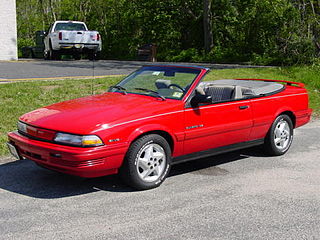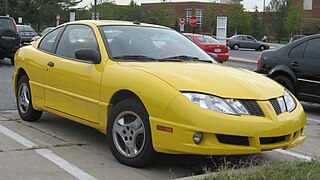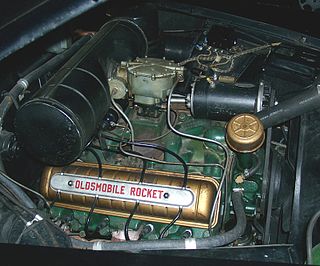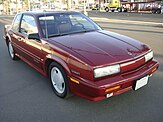
Oldsmobile was a brand of American automobiles, produced for most of its existence by General Motors. Originally established as "Olds Motor Vehicle Company" by Ransom E. Olds in 1897, it produced over 35 million vehicles, including at least 14 million built at its Lansing, Michigan factory alone.

The Pontiac Sunbird is a model line that was manufactured and marketed by Pontiac from the 1976 to the 1994 model years. Loosely deriving its name from the Pontiac Firebird, the Sunbird was introduced as the eventual replacement for the Pontiac Astre, replacing it entirely in 1978 as the smallest Pontiac.

The Pontiac Sunfire is a compact car by Pontiac that was introduced for the 1995 model year to replace the Sunbird. Not only was the name changed, but dramatic styling changes were included as well. The new styling was shared with the redesigned Chevrolet Cavalier. The J platform was updated structurally to meet more stringent safety standards for the 1996 model year.

The Oldsmobile Cutlass was a series of automobiles produced by General Motors' Oldsmobile division between 1961 and 1999. At its introduction, the Cutlass was Oldsmobile's entry-level model; it began as a unibody compact car, but saw its greatest success as a body-on-frame intermediate. The Cutlass was named after Vought F7U Cutlass, as well as the type of sword, which was common during the Age of Sail.

The Oldsmobile Cutlass Supreme is a mid-size car produced by Oldsmobile between 1966 and 1997. It was positioned as a premium offering at the top of the Cutlass range. It began as a trim package, developed its own roofline, and rose during the mid-1970s to become not only the most popular Oldsmobile but the highest selling model in its class.

Buick Century is the model name that was used by Buick for a line of upscale full-size cars from 1936 to 1942 and 1954 to 1958, as well as from 1973 to 2005 for mid-size cars.

The General Motors 60° V6 engine family is a series of 60° V6 engines produced for both longitudinal and transverse applications. All of these engines are 12-valve cam-in-block or overhead valve engines, except for the LQ1 which uses 24 valves driven by dual overhead cams. These engines vary in displacement between 2.8 and 3.4 litres and have a cast-iron block and either cast-iron or aluminum heads. Production of these engines began in 1980 and ended in 2005 in the U.S., with production continued in China until 2010. This engine family was the basis for the GM High Value engine family. These engines have also been referred to as the X engines as they were first used in the X-body cars.

The Oldsmobile Firenza was a compact car which was produced by Oldsmobile from 1982 to 1988. It was based on the front-wheel drive GM J platform, which was shared with the Buick Skyhawk, Cadillac Cimarron, Chevrolet Cavalier and Pontiac Sunbird. It was not based on the European market Vauxhall Firenza, but on the same platform as the Vauxhall Cavalier Mk 2 / Opel Ascona C. The Firenza name was previously used as a performance package on the previous generation Oldsmobile Starfire hatchback.

The Oldsmobile 4-4-2 is a muscle car produced by Oldsmobile between the 1964 and 1987 model years. Introduced as an option package for US-sold F-85 and Cutlass models, it became a model in its own right from 1968 to 1971, spawned the Hurst/Olds in 1968, then reverted to an option through the mid-1970s. The name was revived in the 1980s on the rear-wheel drive Cutlass Supreme and early 1990s as an option package for the new front-wheel drive Cutlass Calais.

The Buick V6 is an OHV V6 engine developed by the Buick division of General Motors and first introduced in 1962. The engine was originally 198 cu in (3.2 L) and was marketed as the Fireball engine. GM continued to develop and refine the 231 cu in (3.8 L) V6, eventually and commonly referred to simply as the 3800, through numerous iterations.

The Oldsmobile V8, also referred to as the Rocket, is a series of engines that was produced by Oldsmobile from 1949 until 1990. The Rocket, along with the 1949 Cadillac V8, were the first post-war OHV crossflow cylinder head V8 engines produced by General Motors. Like all other GM divisions, Olds continued building its own V8 engine family for decades, adopting the corporate Chevrolet 350 small-block and Cadillac Northstar engine only in the 1990s. All Oldsmobile V8s were assembled at plants in Lansing, Michigan while the engine block and cylinder heads were cast at Saginaw Metal Casting Operations.

The Oldsmobile Diesel engine is a series of V6 and V8 diesel engines produced by General Motors from 1978 to 1985. Their design was based on the Olds 350 gasoline engine architecture. A 350 cu in (5.7 L) V8 was introduced in 1978, followed by a 261 cu in (4.3 L) V8 only for the 1979 model year. In 1982, a 263 cu in (4.3 L) V6 became available for both front front-wheel drive and rear-wheel drive vehicles.

The Buick V8 is a family of V8 engines produced by the Buick division of General Motors (GM) between 1953 and 1981. All were 90° water-cooled V8 OHV pushrod engines, and all were naturally aspirated except one turbocharged version of the 215.

Quad 4 is the name of a family of principally DOHC inline four-cylinder engines produced by General Motors' Oldsmobile division between 1987 and 2002; a single SOHC version was built between 1992 and 1994.

Following the success of Hurst components in Oldsmobile's 442 models, Oldsmobile, in collaboration with Hurst Performance of Warminster, Pennsylvania, produced special-edition performance versions of the 442 or Cutlass Supreme, the Hurst/Olds.

The Oldsmobile Cutlass Ciera is a mid-size car manufactured and marketed for model years 1982-1996 by the Oldsmobile Division of General Motors — over a single generation. Body styles included a 2-door coupe, 4-door sedan, and the 4-door wagon.

The 122 engine was designed by Chevrolet and was used in a wide array of General Motors vehicles. The 122 was similar to the first two generations of the General Motors 60° V6 engine; sharing cylinder bore diameters and some parts. The 122 was available in the U.S. beginning in 1982 for the GM J platform compact cars and S-series trucks.

The Oldsmobile Achieva is a front-wheel drive compact sedan and coupe that was introduced by Oldsmobile for the 1992 model year. The Achieva was based on the GM N-body platform, which it also shared with its siblings the Pontiac Grand Am and Buick Skylark. The Achieva replaced the GM N-body Cutlass Calais after its final 1991 model year, and ended production after the 1998 model year.

The Pontiac Grand Am is a car model that Pontiac Division of General Motors produced in various years between 1973 and 2005. The first and second generations were RWD mid-size cars built on the LeMans GM A platform. The Grand Am name was reused for a FWD compact car for the third- and fourth-generations. The fifth-generation versions was enlarged to a mid-size car.
The GM A platform was a rear wheel drive automobile platform designation used by General Motors from 1925 until 1959, and again from 1964 to 1981. In 1982, GM introduced a new front wheel drive A platform, and existing intermediate rear wheel drive products were redesignated as G-bodies.
























